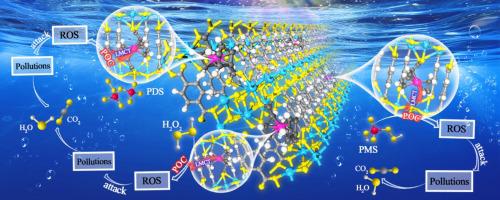Ferrocenedicarboxylate modified Bi-MOF for water decontamination via different advanced oxidation processes: Multifunction, mechanisms and biotoxicity test
IF 13.3
1区 工程技术
Q1 ENGINEERING, CHEMICAL
引用次数: 0
Abstract
Peroxymonosulfate (PMS), peroxydisulfate (PDS) and hydrogen peroxide (HO)-based advanced oxidation processes are extensively applied for aqueous pollutants degradation. However, few cases reported the comparison the PMS, PDS and HO activation performances of a heterogeneous catalyst. In this work, 1,1′-ferrocenedicarboxylate (Fc) modified Bi-BDC (Bi-BDC-Fc) with unique electronic structure and strong oxidation ability was synthesized and applied for degrading bisphenols (BPs) photocatalytic PMS, PDS, and HO activation, respectively. The optimum Bi-BDC-Fc exhibited the best photocatalytic PMS, PDS and HO activation performance to degrade various organic pollutants, including BPs, in which the bisphenol A degradation efficiencies followed the order of Bi-BDC-Fc/UVL/PMS, Bi-BDC-Fc/UVL/PDS and Bi-BDC-Fc/UVL/HO. The reaction mechanisms of photocatalytic PMS, PDS and HO activation over Bi-BDC-Fc were comprehensively clarified by experimental results along with DFT calculations. Also, the toxicity and ecotoxicological impact of the pristine BPs and their intermediates were evaluated by the phytotoxicity experiments and zebrafish early-life stage toxicity test. This work presented a comprehensive investigation of degradation performance and the ecotoxicology assessment of Bi-BDC-Fc/UVL/PMS, Bi-BDC-Fc/UVL/PDS, and Bi-BDC-Fc/UVL/HO systems, providing valuable insights to design and utilize the newly developed catalysts for water purification.

二羧酸铁改性 Bi-MOF 通过不同的高级氧化过程进行水净化:多功能、机理和生物毒性测试
基于过一硫酸盐(PMS)、过二硫酸盐(PDS)和过氧化氢(HO)的高级氧化工艺被广泛应用于水体污染物的降解。然而,很少有报道对异质催化剂的 PMS、PDS 和 HO 活化性能进行比较。本研究合成了具有独特电子结构和较强氧化能力的 1,1′-二羧酸铁(Fc)修饰 Bi-BDC(Bi-BDC-Fc),并将其分别用于降解双酚(BPs)的光催化 PMS、PDS 和 HO 活化。最佳Bi-BDC-Fc在降解包括BPs在内的多种有机污染物方面表现出最佳的光催化PMS、PDS和HO活化性能,其中双酚A的降解效率依次为Bi-BDC-Fc/UVL/PMS、Bi-BDC-Fc/UVL/PDS和Bi-BDC-Fc/UVL/HO。实验结果和 DFT 计算全面阐明了 Bi-BDC-Fc 光催化活化 PMS、PDS 和 HO 的反应机理。此外,还通过植物毒性实验和斑马鱼早期毒性试验评估了原始 BPs 及其中间产物的毒性和生态毒理影响。该研究全面考察了 Bi-BDC-Fc/UVL/PMS、Bi-BDC-Fc/UVL/PDS 和 Bi-BDC-Fc/UVL/HO 体系的降解性能和生态毒理学评估,为设计和利用新开发的催化剂进行水净化提供了宝贵的见解。
本文章由计算机程序翻译,如有差异,请以英文原文为准。
求助全文
约1分钟内获得全文
求助全文
来源期刊

Chemical Engineering Journal
工程技术-工程:化工
CiteScore
21.70
自引率
9.30%
发文量
6781
审稿时长
2.4 months
期刊介绍:
The Chemical Engineering Journal is an international research journal that invites contributions of original and novel fundamental research. It aims to provide an international platform for presenting original fundamental research, interpretative reviews, and discussions on new developments in chemical engineering. The journal welcomes papers that describe novel theory and its practical application, as well as those that demonstrate the transfer of techniques from other disciplines. It also welcomes reports on carefully conducted experimental work that is soundly interpreted. The main focus of the journal is on original and rigorous research results that have broad significance. The Catalysis section within the Chemical Engineering Journal focuses specifically on Experimental and Theoretical studies in the fields of heterogeneous catalysis, molecular catalysis, and biocatalysis. These studies have industrial impact on various sectors such as chemicals, energy, materials, foods, healthcare, and environmental protection.
文献相关原料
公司名称
产品信息
麦克林
1,1′-Ferrocenedicarboxylic acid
麦克林
Ofloxacin
麦克林
4,4′-Sulfonyldiphenol
百灵威
bisphenol A (BPA)
阿拉丁
Bismuth nitrate pentahydrate
 求助内容:
求助内容: 应助结果提醒方式:
应助结果提醒方式:


